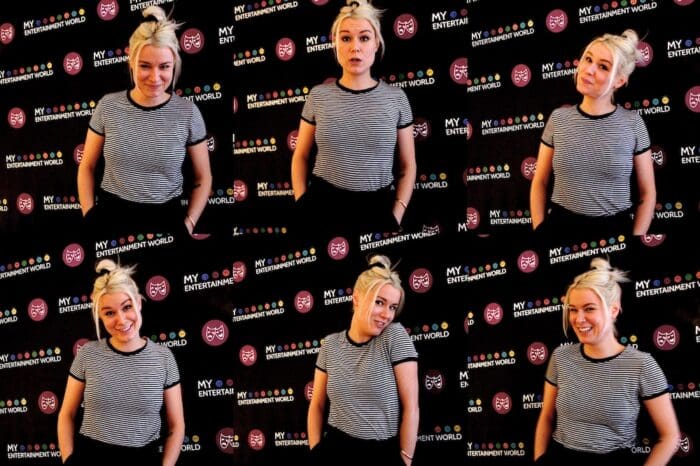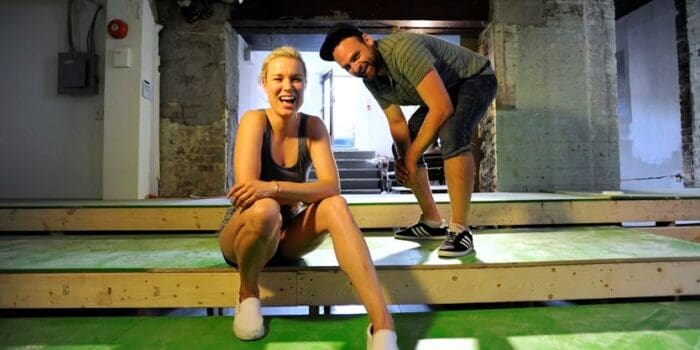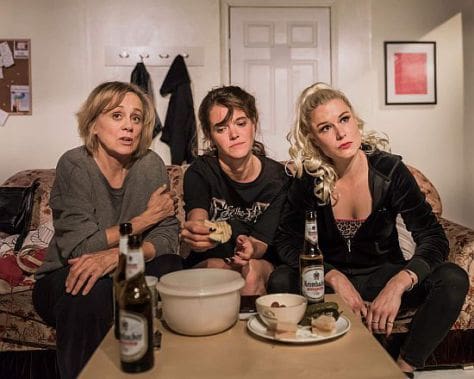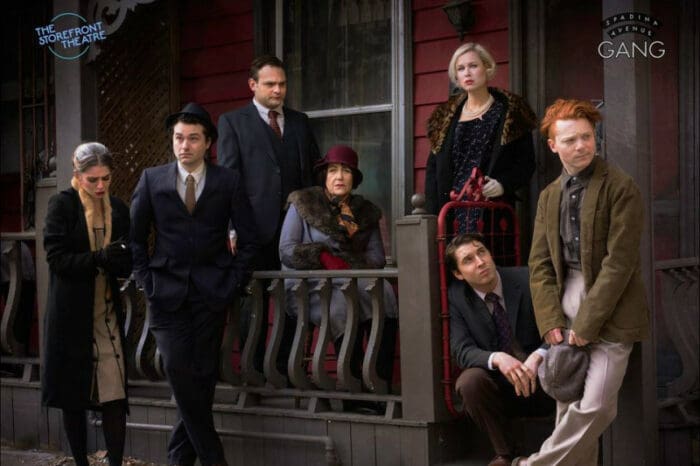 Before we announce the winners of the 2017 MyEntWorld Critics’ Pick Awards, we’re proud to present our annual Nominee Interview Series.
Before we announce the winners of the 2017 MyEntWorld Critics’ Pick Awards, we’re proud to present our annual Nominee Interview Series.
The wonderful Anne van Leeuwen is a force in Toronto indie theatre. She’s got this crazy indomitable spirit that manifests itself in pure ambition and prolific output as a director, a performer, an artistic director, and now a theatre owner (she’s one of the co-founders of the new Assembly Theatre in Parkdale). As an actress, she never fails to make an impression, including in the Outstanding Ensemble-nominated cast of Tough Jews with the Storefront Theatre last spring, one of our most nominated productions of the year.
You’ve had quite the year since last year’s Nominee Interview Series. Tell us about opening the Assembly, and some of the interesting challenges you’ve faced thus far.
When I moved to Toronto in 2012, having my own space was part of my five-year plan. And so, from a series of unfortunate events, for some people- Unit 102- that dream came to fruition. I made it right under the wire for the five-year plan.
It’s a lot of work. Way more than I anticipated. The Unit 102 guys made that look so easy, but I guess the biggest lesson I’ve learned doing it, and the lesson I continue to learn, is diplomacy. [laughs] And patience. The constant need to keep fighting, to keep it afloat, and to keep everyone happy. To keep the indie storefront theatre alive. It is a constant, constant struggle.

Do you have a new five-year plan since your five years expired? What’s the general hope for the future of the Assembly?
It’s hard to see beyond keeping afloat at this point, but I think the long-term plan is endearing ourselves in the hearts of the Parkdalians so we don’t lose our space at the end of our three-year lease. Continuing to build a relationship with the neighbourhood there, and to get some government funding for the space, and for the artists who work there – because right now, although they say never put your own money into the business, there have been a couple of months where we’ve had no other choice. Luis Fernandes and Melissa Wright and myself have had to throw whatever we can of our own money into the space. It’s a lot. Worth it, though.

One of the reasons it’s worth it is that you have a home for your company Leroy Street. The company had their debut in this new space with The Chance. Tell us a little bit about that experience.
Oh, man. [laughs] Just so many dreams coming true there. I mean, working with two Canadian legends – Mr. George F. Walker [playwright] and Ms. Fiona Reid– and a project that really kind of fell into my lap.
Wes Berger, who directed the show, had seen me in Hedda Gabler three or four years ago, remembered me from that, and reached out. But I had never met him before. I think he reached out via Facebook. [laughs] Good old Facebook. [He] asked if I would come to a reading of The Chance, and he didn’t know what he was going to do with it until I went. We did the reading with two different actresses – not the ones who ended up playing the parts in the show. And after the reading, I loved the play, and I asked him, “What are you doing with it?” and he said he didn’t know, and I said “Well, who’s producing it?” And he said, “I don’t know,” and I said, “Well, guess what, I am”.
He actually sent George F. Walker my interview that I did with you from last year, and said, “This is the woman who wants to produce your show.” George wrote back and said, “Yeah, she seems like she knows what she’s talking about. She seems gutsy, and she seems to know what she wants, so let’s go with it.”
And thus began my working relationship with Mr. George Walker. Which is great. He was in the room towards the end of the rehearsal process a lot. It’s great to have the writer in the room, because he can see what we’ve done with the characters so far, and how we’ve made them our own. Based on our interpretations of these characters, he starts writing lines which are more in tune with what we’ve been working on. So it was a really cool process. Just being able to yell out into the audience, “George, this isn’t working for me – can we try something else?” And in general, he was pretty amenable to that.
![]() You also appeared in Letters to Annabelle this year. How did that role come about?
You also appeared in Letters to Annabelle this year. How did that role come about?
This is the whole odd series of events here. Yehuda Fisher, who directed Letters to Annabelle, had read the play years ago, when Stevie [Joffe, playwright] first wrote it in a state of heartbreak. When [Yehuda] got a slot in the Fringe, he thought back over all the stuff that he’d seen and read over the past few years, and thought of Letters to Annabelle, and approached Stevie about producing it for the Fringe Festival.
Because I had just worked with Stevie on Tough Jews, Stevie recommended me for the role of Annabelle. And that’s how that came about. I just said yes, because I trusted Stevie, having worked with him on Tough Jews. I didn’t know anything about Yehuda, and I’d never done the Toronto Fringe before. That’s something I feel you have to do if you’re a theatre artist in Toronto.
Your character had become, in the main character’s imagination, sort of larger than life, this crazy dream girl. How was your experience playing that?
[laughs] It was a struggle, because that’s certainly not how I see myself. I think the biggest challenge about it was the dancing – which I didn’t realize, having just read the script, there was going to be so much of. It seemed like a little ball-change kick here, a little ball-change kick there. But when Yehuda got his hands on it, he wanted to incorporate a lot more of the burlesque world into the play, and so we had a choreographer and the whole nine yards.
Our choreographer, Danielle Oswald, is a Randolph graduate, and just a fabulous, fabulous dancer and very patient teacher. I hadn’t danced in about 15 years, and it’s not like riding a bike. If you don’t exercise that muscle, she gone. I couldn’t retain the information. I felt ridiculous doing these steps, or not doing them, as the case was, because here I was supposed to be portraying this dream girl who’s all elegant and razzle-dazzle, and I’m tripping over my own feet. But like I said, the choreographer was very patient, and she worked very diligently with me for about a week and a half before she had to go to LA. So I had a week and a half to learn three different dances to a point where she felt comfortable leaving me alone with that choreography. I don’t know that she ever did, but we pulled it off.

How did you get involved in Tough Jews?
Michael Ross Albert [playwright] had seen me in Old Times, and I’d met him a couple of times before that. Anyway, he reached out – yes, on Facebook! – and asked me if I would come audition for Tough Jews, for Margie, and sent me a couple of sides.
I hadn’t read the whole play. I didn’t know much about it, so I memorized all the lines, and I just went in there and tried to pretend that I wasn’t the most nervous ever. I hadn’t auditioned for anything in so long, because so many of the projects that I do are collaborations or my own company’s work. You know that old mantra – if you wanna work, make work – so I was a little rusty on the audition side of things. Obviously not that rusty, because I did get the part. [laughs]
You talked about George being part of the rehearsal process. How involved was Michael, and what was it like working with him?
We didn’t really see him in the room. Because he was a producer on it, we saw him more in that capacity once we moved into Kensington Hall. He came into a couple of rehearsals, and answered any questions that we’d been storing up over the rehearsal process. He’s a delight to work with, because he cares so much about the actors bringing these characters to life that he wants things to be as crystal-clear for you as possible. If things aren’t making sense to you, he will sit down and talk to you for hours about your questions. He’s a dream to work with.
The play was based on real events on Toronto. How much research did you do into the period and the lives of these characters?
Ben Blais, who directed it, was quite insistent – we did a lot of table work, a lot of research. Not so much specific to those events – although we did look into [those] a lot – but into Judaism. We went through that a lot. Theresa Tova and Maaor [Ziv] were great about going through all of the Jewish traditions that would matter to this family, which was very important to the family that the show was about. Less [important] for my character, but we did a lot of research on that. A lot of talking.
You played the one outsider who wasn’t a blood family member. How did you approach that dynamic in working with the ensemble?
Well, it’s partly in doing it on my own, and partly it happening naturally. It was kind of lonely, and it was a little bit isolating, because I was more of a minor role than the others. They had a lot more stage time together, and had a chance to build more relationships on and off the stage, because I was not onstage as much as they were. That kind of environment lent itself very nicely to developing that character, because she is very isolated and lonely in this family, and I think all she wants to do is be a part of it, really.
Tell us a little bit about working with Ben as the director.
[laughs] Ben’s great. He’s an actor’s director, and he and I have kind of similar ways of directing that is approaching it from an acting side of things. So he asks a lot of questions, to which he demands answers, and he does a lot of team building work with the ensemble. He is very focused in the room, and he’s very dedicated to finding the nuance in the script with the actors. He’s not afraid to push you when he knows that you can be pushed.
Did you have a favourite moment in the show?
The prologue, which is just total madness. It’s action-packed, and it feels like the thing is over in 30 seconds, but really, it’s probably about five minutes long. The [fight] choreography of that scene, by Simon Fon, was so intricate, and it took hours and hours to do. When it happened, it was just like immediate adrenaline. As soon as the light goes up, gunshots, and it’s just everything you’ve got. You gotta get out in four minutes, and it’s like you black out. You don’t even remember it happening, when the lights go back out. It’s so exhilarating, and it just sets up the whole show, and you don’t have to worry about finding your energy when you come back out onstage, because it’s already still there from that first moment.
What are you working on now?
I’m directing a new piece by Daniel Pagett called Homewrecker. We’re doing a co-production with Coyote Collective. [ON STAGE NOW, until March 10th at The Assembly Theatre- get your tickets HERE].
Do you have anything else coming up that you want to talk about?
I’m working on George F. Walker’s trilogy of which The Chance is a part. People Live Here is what it’s called. It’s kind of like the motel trilogy that he wrote years back, so it’s these three stories that all take place in the same apartment complex in a neighbourhood not unlike Parkdale, where the Assembly Theatre happens to be, and where I happen to live. So we have partnered with Storefront, and with Michelle Langille of Inamorata- although I don’t believe Inamorata is technically producing it, I think she’s acting as the separate entity.
We’re working on that for the fall, so we’ll be remounting The Chance, and the Storefront will be producing the second part of the trilogy called Kill the Poor, which I’ll be directing. Michelle’s group will be producing the third instalment, called Her Inside Life. The three of them will all be happening in rep over a five-week period, so we’re hoping it will be a real Toronto theatre event in the fall.
